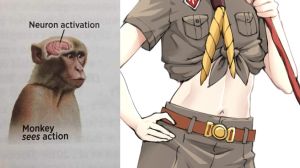Neuron Activation
The "Monkey See, Monkey Do" Phenomenon: Neuron Activation, Primate Behavior, and Your Daily Commute
The "neuron activation meme" humorously captures the concept of mirror neurons, a fascinating aspect of primate neurology. These specialized neurons fire both when we perform an action and when we observe someone else performing the same action. This mirroring process plays a crucial role in learning, empathy, and social interaction.
Monkey See, Monkey Do, Monkey Drive
While often associated with primates mimicking each other's behavior (hence the phrase "monkey see, monkey do"), mirror neurons are also at play in our everyday lives. One prime example is driving in traffic.
When you're behind the wheel, you're constantly observing the actions of other drivers. You see them brake, accelerate, change lanes, and signal turns. Your mirror neurons fire as if you were performing those actions yourself, helping you anticipate their movements and react accordingly.
This mirroring process is essential for learning how to drive. As a novice driver, you rely heavily on observing and imitating experienced drivers to understand the rules of the road and develop safe driving habits. Even as a seasoned driver, you continue to learn from others, subconsciously adjusting your behavior based on the actions of those around you.
The Neural Symphony of Traffic
Imagine a bustling city street: a symphony of brake lights, turn signals, and accelerating engines. Your brain's mirror neuron system is working overtime, processing a constant stream of visual and auditory cues.
You see a car ahead of you suddenly brake, and your mirror neurons fire, triggering a similar response in your own brain. You instinctively lift your foot off the gas pedal and prepare to brake as well. This split-second reaction, facilitated by mirror neurons, can be the difference between a safe stop and a rear-end collision.
Learning From the Masters
The same neural mechanisms that help you navigate traffic also enable you to learn from other drivers' mistakes. When you witness a reckless maneuver or a near-miss accident, your mirror neurons fire, creating a visceral experience that helps you understand the potential consequences of such actions.
This vicarious learning allows you to refine your own driving skills and avoid similar mistakes. You might subconsciously adopt a more cautious approach after witnessing a close call, or you might learn a new driving technique by observing a skilled driver navigate a challenging situation.
Beyond Driving: Mirror Neurons and Social Learning
The influence of mirror neurons extends far beyond driving. They play a crucial role in various aspects of our lives, including:
- Language acquisition: We learn to speak by imitating the sounds and gestures of others.
- Emotional contagion: We "catch" the emotions of those around us through facial expressions and body language.
- Skill development: We learn new skills by observing and imitating experts.
- Empathy and social bonding: We connect with others by mirroring their feelings and understanding their perspectives.
The Power of Imitation
The "monkey see, monkey do" phenomenon, fueled by mirror neurons, is a fundamental aspect of human nature. It allows us to learn from others, adapt to our environment, and build social connections.
So, the next time you find yourself chuckling at a neuron activation meme, remember that those tiny cells are working tirelessly to help you navigate the complexities of human interaction, whether it's on the road or in your daily life.
